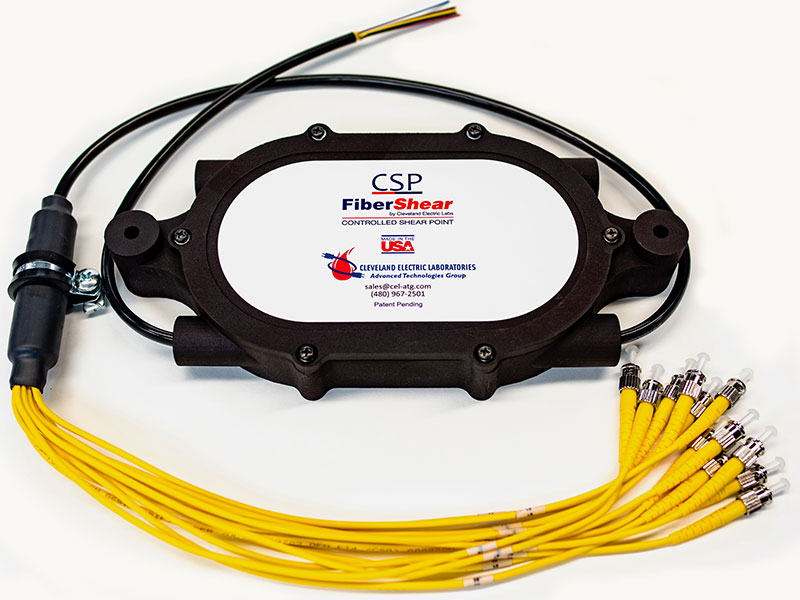CSP Fiber Optic Control Cabinet Connectivity

CSP FiberShear Direct Connect Technology protects cabling infrastructure by preventing stress applied to the cable in a typical hard wired connection. CSP allows the cable to be control sheared at the base of the cabinet or structure, preventing stress on both the cable in the ground and the cable connecting to the electrical device. This innovative technology guarantees that all cabling infrastructure remains intact in the event of an accident and enables cabinet or device restoration to take place within minutes of the equipment being reset. This patent pending, made in the USA, innovative device was designed to eliminate patch cords, redundant maintenance and additional failure points, ultimately saving cost.
CSP Fiber Optic Controlled Shear Point
Controlled Shear Point (CSP) FiberShear Direct Connect Technology protects cabling infrastructure by preventing stress applied to the cable in a typical hard-wired connection. CSP allows the cable to be control sheared at the base of the cabinet or structure, preventing stress on both the cable in the ground and the cable connecting to the electrical device. This innovative technology guarantees that all cabling infrastructure remains intact in the event of an accident and enables cabinet or device restoration to take place within minutes of the equipment being reset. This patent pending, made in the USA, innovative device was designed to eliminate patch cords, redundant maintenance, and additional failure points, ultimately saving cost.
Installation of CSP eliminates the need for patch cables, replacing them with direct connect outdoor-rated fiber fan-out. It also eliminates secondary maintenance or failure point connections in the cabinet. CSP phases out unnecessary circuit losses and reduces loss by as much as half a dB.
CSP Guarantees a stress-free breakaway in the event of a traffic incident and ensures rapid restoration with a single fixed and preconfigured emergency splice chamber. Offers easy installation with multiple mounting options.
Provides operating options in 50-foot increments of 2 fiber, 4 fiber, 6 fiber, or 12 fiber drop cable configurations. Allows for pre-installed drop cables for splicing the interconnect in the CSP splice chamber and for mid-span access module to convert existing cabinets without disabling the fiber circuit. CSP reduces warehouse inventory with the all-in-one delivery package reducing space and includes all hardware for complete installation.
CSP allows for effective traffic incident management by reducing the duration and impact of obstructive traffic incidents and the occurrence of secondary collisions, which improves the safety of motorists, crash victims, and emergency responders.
Patch cables are used to interface between a patch panel or termination bar and cabinet equipment. They are often used to offer a quick means of swapping leads or preventing excessive strain on the equipment ports, in the event that the connecting cable is disturbed.

The Problem with Patch Cables
Patch cables are one of the least reliable components in the transportation industry fiber optic system because the jacketing material they are made of is not designed for uncontrolled environmental conditions.
This often results in high maintenance costs and premature failure of circuits. Additionally, if they are to be used as a shear point in the event of a cabinet strike, the pull tension of a single fiber jumper can inconsistently range between 15 and 200 pounds. This offers little or no protection for the fragile equipment ports to which the patch cable is attached.
Detecting Shear
Fiber optic shear detectors are a type of sensor that can be used to detect shear. Shear is a type of deformation that can occur when two objects are pulled apart. Shear can cause problems with the transmission of signals through fiber optic cables and can also lead to the breakage of the cables. Fiber optic shear detectors are often used to monitor the health of fiber optic cables.
Shear detection is critical in fiber optic networks and other applications that require high-speed transmission of data. Fibers can be susceptible to shear damage, which can cause them to fail. A fiber optic shear detector can help prevent this failure by detecting the shear stress on the fibers and warning operators if there is a problem.
How Does a Fiber Optic Shear Detector Work?
A fiber optic shear detector is an essential tool for inspecting and diagnosing fiber optic networks. It is used to identify any shear or bending in the optical fibers, which can cause signal loss and other issues.
The basic principle of a fiber optic shear detector involves using a light source and a detection system to shine light into the fiber and detect any changes in intensity. The detector then uses this data to calculate the amount of shear or bending present in the fiber. This information can be used to diagnose problems with the network and correct them before they become major issues.
Benefits of Using a Fiber Optic Shear Detector
There are a few key features that make the fiber optic shear detector unique. The first is its ability to detect shear in fibers up to 2,000 meters long. This makes it superior to traditional shear detection methods which can only detect shear at shorter distances.
The second feature is the device’s versatility. It can be used for both static and dynamic measurements of shear stress in materials.
Finally, the fiber optic shear detector has several benefits over traditional devices. For instance, it is less expensive than other options and is easier to operate due to its design.
Advantages of CSP FiberShear
Although cost savings was the objective, the ease of installation and the breakaway properties of the Cleveland Electric Labs CSP FiberShear self-contained splice case was the best choice for our fiber optic splicing needs.


